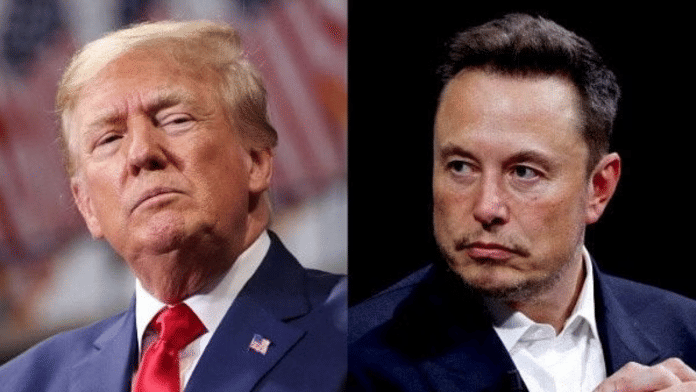Can Indian Prime Minister Narendra Modi, now in power since 2014, pull off what his American counterpart Donald Trump has done just over a month into his second term? Determined to downsize the federal government, Trump hit the ground running by enlisting the services of the newly-formed Department of Government Efficiency (DOGE).
DOGE was set up through an executive order issued by Trump hours after his inauguration. Its mandate: “modernising federal technology and software to maximise governmental efficiency and productivity”.
And the man chosen to lead this mammoth effort, Tesla and SpaceX founder Elon Musk. Though Musk isn’t the only Silicon Valley product roped in to reboot the American federal government. David Sacks, also a former early PayPal executive, for instance, is Trump’s AI and crypto czar.
The idea, while it is one whose time has come, is not entirely novel. Reagan embarked on this most reasoned pursuit with the formation of the “Grace Commission” in 1982. Its task was to weed out inefficiencies and reduce government spending with the help of “outstanding experts from the private sector”. The difference is the DOGE agenda is the first time a US president is deploying technology to streamline and reboot the government.
Why did DOGE ideologue Musk feel the pressing need to slash the federal payroll by as much as 75 percent? The answer lies in the numbers.
Data from the US Office of Personnel Management (OPM) and the Bureau of Labor Statistics (BLS) shows that, as of November 2024, the US federal government employed more than 3 million people—making it the country’s single largest employer. For context, Walmart’s total employee strength despite it being the world’s largest private employer, is about 2.3 million.
Public sentiment, too, is in favour of this downsizing of government. A Pew survey conducted in April 2024 found that about 56 percent of Americans said the government is “almost always wasteful and inefficient”.
On its part, the government too did very little to inspire confidence in the public or the private sector. The Biden administration’s feverish targeting of tech giants including Meta during the COVID-19 crisis was a case in point. It highlighted how overreach harms the interests of all stakeholders.
In contrast, the bid to rope in Silicon Valley veterans to cut the size of government will not only benefit taxpayers but also generate new investment opportunities and usher in a new age of tech talent.
Also read: Modi-Trump bonhomie changes nothing for India. Get real, Hindutva fans
If US can reboot its govt, so can India
Data from the Indian finance ministry’s Pay Research Unit (PRU) shows that as of 1 March 2023, the total number of regular central government employees (excluding armed forces personnel) stood at 3.6 million as against the sanctioned strength of 4.4 million. Five ministries or departments accounted for almost 92 percent of the total manpower, namely Railways, Defence (Civil), Home Affairs, Posts and Revenue.
The total expenditure on pay and allowances incurred to maintain this workforce was Rs 2.75 trillion ($31.49 billion), an increase of 7.41 percent compared to the previous fiscal year. A little over 60 percent of this went into salaries and another 21 percent into dearness allowance, which is seen as a cost-of-living adjustment in the form of an increase in basic pay.
What the Modi government must note is that its mantra of “minimum government, maximum governance” is yet to be fully put into action, given that the size of the central government workforce was 3.8 million in 2011.
For about five years, the Indian government was on a mission to downsize its workforce which reached its lowest point in nearly a decade in 2023, before the trend witnessed a reversal in 2024. Merging departments or public sector undertakings (PSUs), though done with the right intention, is unlikely to wield any significant change in the longer run.
With his vast experience in governance spanning nearly three decades, Prime Minister Modi can take a cue from the DOGE agenda and launch a comprehensive and sustained effort to cut the size of government. And the timing couldn’t be better. The Cabinet recently notified the formation of the 8th Pay Commission—a panel of experts constituted once every 10 years to recommend changes to the salary structure of government employees.
The Pay Commission can exercise its discretion to conduct an encyclopedic review of government and make recommendations aimed at achieving a critical aim—to make the government leaner and more efficient. For this, the government can rely on its vast pool of technocrats and tech experts who can help streamline and restructure the system.
One key aspect of this much-needed governance reform is to muster political consensus, which Prime Minister Modi is equipped to do.
Bottom line: there is no better time to hit the reset button; if President Trump can take this challenge head-on, so can Prime Minister Modi.
Asha Jadeja is a Silicon Valley-based entrepreneur, venture capitalist, philanthropist and a ‘change agent’. She tweets @ashajadeja325. Views are personal.
This article is sponsored by the Motwani Jadeja Foundation.






